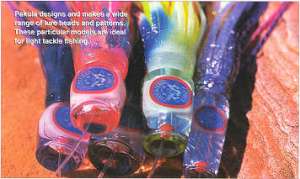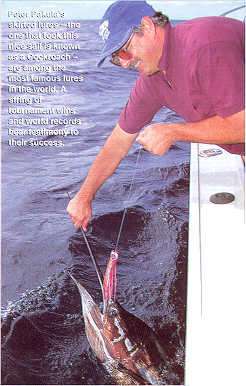Pakula Story
Fishing World November 1998 by Col Roberts
 The name 'Pakula' conjures up images of, and is synonymous with, skirted billfish lures. Peter Pakula is, without doubt, Australia's best-known manufacturer of skirted lures. Based on Queensland's Gold Coast, he has gained numerous accolades from overseas game fishermen. This no doubt explains why 90 percent of his lures are now exported. In fact, at this year's prestigious Hawaiian International Billfish Tournament, Pakula was bestowed the honour of having his lures named as the official lures of the event.
The name 'Pakula' conjures up images of, and is synonymous with, skirted billfish lures. Peter Pakula is, without doubt, Australia's best-known manufacturer of skirted lures. Based on Queensland's Gold Coast, he has gained numerous accolades from overseas game fishermen. This no doubt explains why 90 percent of his lures are now exported. In fact, at this year's prestigious Hawaiian International Billfish Tournament, Pakula was bestowed the honour of having his lures named as the official lures of the event.
While talking of game fishing events, it's interesting to note that Pakula lures have accounted for a large number of world billfish tournament wins as well as many records. In many respects, his lures have been responsible for a shift in emphasis in the Cairns giant black marlin fishery. It wasn't all that long ago that many Cairns skippers believed the giant blacks wouldn't take a lure. How things have changed! Quite a few skippers now use skirted lures with great success. For instance, during the '97 season, it's claimed that nine granders were caught on Pakula lures, including the heaviest fish of the season - a 1,185 pound beast, which, incidentally, is also the heaviest marlin ever caught in Australia on a lure.
Peter Pakula has been making lures since 1987. like most successful lure manufacturers, it's the minute attention to detail (or, as Pakula likens it, "knowing which detail to pay attention to") which has earned him such success. Pakula is a thinking fisherman who has strong views on piscatorial issues - even to the point of upsetting some in the angling world. He is continually testing his lures and terminal tackle where it counts most - out on the bluewater battlefield. As a result, minor innovations and adjustments have been made over the years to further enhance the performance of his products.
 Pakula is also very professional in the way he runs his business. He is very much into the computer age with websites containing the latest news and capture information, articles on rigging lures and game fishing newsletters, catalogues, a video titled Bluewater Magic ~ the Secrets of Trolling Lures for Gamefish, and even a booklet titled Pakula - Unlocking the Seacrets, Offshore Sport and Game Fishing which contains a wealth of information on virtually everything needed to tangle with ' bluewater game species. While some unkind people could say that all of this material helps sell product (which no doubt it does), those who know Pakula are aware that he is extremely generous in giving out information to aid successful fishing. It's the small, salient points that Pakula is happy to share with all corners that can make the difference between success or otherwise.
Pakula is also very professional in the way he runs his business. He is very much into the computer age with websites containing the latest news and capture information, articles on rigging lures and game fishing newsletters, catalogues, a video titled Bluewater Magic ~ the Secrets of Trolling Lures for Gamefish, and even a booklet titled Pakula - Unlocking the Seacrets, Offshore Sport and Game Fishing which contains a wealth of information on virtually everything needed to tangle with ' bluewater game species. While some unkind people could say that all of this material helps sell product (which no doubt it does), those who know Pakula are aware that he is extremely generous in giving out information to aid successful fishing. It's the small, salient points that Pakula is happy to share with all corners that can make the difference between success or otherwise.
 Pakula lures began with solid coloured flexible heads, followed by clear flexible heads with flexible inserts and red nylon leader tube. The next stage resulted in heads made of hard polyester resin and, initially, Yo Zuri skirts. In 1995 Seven Strand skirts were utilised. The most radical change occurred in 1997 with the re-introduction of clear flexible heads known as the Softease range. They are not as pliable as other softheads on the market but, according to Pakula, are "just soft enough to feel natural". Other than the natural feel, the heads are lighter than normal heads, they don't suffer the ravages of chipping and have a more aggressive action in the water.
Pakula lures began with solid coloured flexible heads, followed by clear flexible heads with flexible inserts and red nylon leader tube. The next stage resulted in heads made of hard polyester resin and, initially, Yo Zuri skirts. In 1995 Seven Strand skirts were utilised. The most radical change occurred in 1997 with the re-introduction of clear flexible heads known as the Softease range. They are not as pliable as other softheads on the market but, according to Pakula, are "just soft enough to feel natural". Other than the natural feel, the heads are lighter than normal heads, they don't suffer the ravages of chipping and have a more aggressive action in the water.
When developing the Softease range Pakula came across a material so clear and tough that he is now using it in his new range of hard heads - appropriately named the "Diamond Head" series. The compound contains UV stabilisers and Pakula claims to have belted lures made of it with a hammer only to smash the bricks underneath without even scratching the heads.
Now to the nitty-gritty of lure selection. Given that it's the boat and its wash and associated teasers that attract fish to the strike range, it's necessary to place lures beyond the influence of prop wash or boat turbulence. The heads are designed for specific positions, thus the closer to the boat the larger and more aggressive the lure should be with a decrease in size and action further aft. Pakula's preferred placement of lures has been determined after years of experimentation, other anglers' successes and tournament wins. There are thousands of colour combinations available, although a common thread applies to Pakula's preferred billfish patterns. That is: the long outrigger position is green, the short, rigger purple, the long corner blue and the short corner black or a combination of black. These colours match the most common baitfish colours found around the world and range from very bright to very dark, giving variation to the various silhouettes. In addition, the skirts also have luminous and fluorescent additives to further enhance visibility and imitate wounded baitfish.
Pakula notes that all fishing areas have their own "hot' colour - such as black and red or yellow around tropical reefs, pink in the light tackle fishery and blue and pink in Hawaii. He encourages anglers to use hot local colours but stresses that they be an addition to, and not a substitution of, the lure colours in the main pattern. And that's not a bad policy to adopt - stick with what works around the world but still experiment with a fifth or (depending on the size of the boat) sixth colour pattern. This may well apply to developing billfish areas.
Next column I plan to delve into the intricacies of Pakula's preferred rigging techniques, terminal tackle and tips on fishing tactics. Stay tuned!






